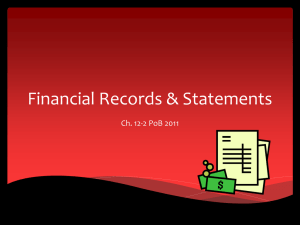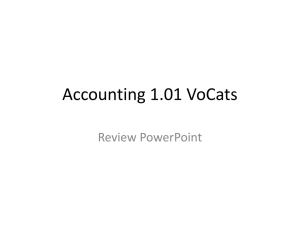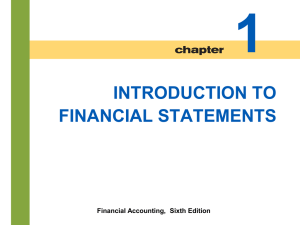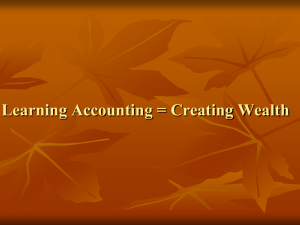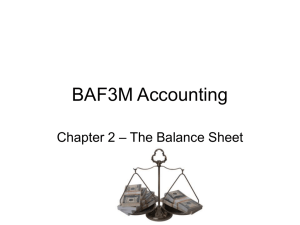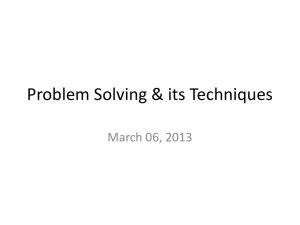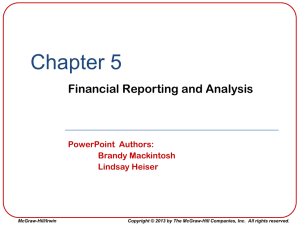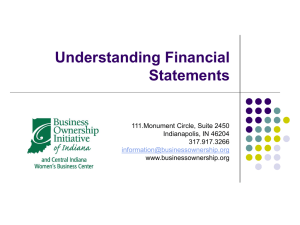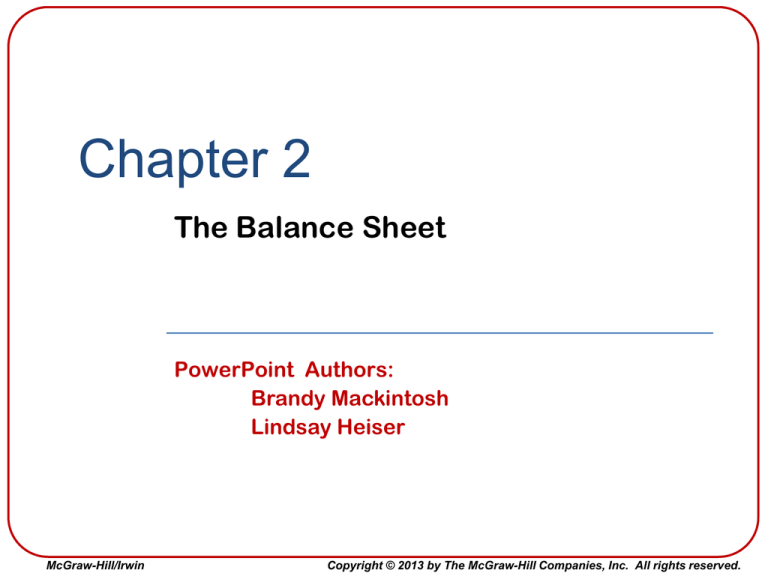
Chapter 2
The Balance Sheet
PowerPoint Authors:
Brandy Mackintosh
Lindsay Heiser
McGraw-Hill/Irwin
Copyright © 2013 by The McGraw-Hill Companies, Inc. All rights reserved.
Learning Objective 2-1
Identify financial effects of
common business activities
that affect the balance sheet.
2-2
Building a Balance Sheet
Assets
resources presently owned by a
business that generate future
economic benefit.
=
Liabilities
amounts presently owed by a
business to creditors.
+
Stockholders’
Equity
2-3
the amount invested and
reinvested in a company by its
shareholders.
Financing and Investing Activities
Assets
Companies rely on
Invest
inofAssets
two
sources
financing:
=
2-4
Liabilities
Debt Financing
+
&
Stockholders’
Equity
Equity Financing
Financing and Investing Activities
Key Features
2-5
Your Goals
1. A company always documents
its activities.
Picture the
documented activity.
2. A company always receives
something and gives something.
Name what’s
exchanged.
3. A dollar amount is determined
for each exchange.
Analyze the
financial effects.
Transactions and Other Activities
2-6
External
Exchanges
Exchanges involving assets,
liabilities, and stockholders’
equity that you can see
between the company and
someone else.
Internal
Events
Events occurring within the
company, for example, using
some assets to create an
inventory product.
Learning Objective 2-2
Apply transaction analysis to
accounting transactions.
2-7
Study the Accounting Methods
A systematic accounting process is used to
capture and report the financial effects of a
company’s transactions.
1 Analyze
2 Record
3 Summarize
A transaction is a business activity that affects the
basic accounting equation.
2-8
Duality of Effects
A = L+ SE
Every transaction has at least
two effects on the basic
accounting equation.
Assets must equal liabilities
plus stockholders’ equity for
every accounting transaction.
Step 1: Analyze Transactions
The chart of accounts is tailored to each company’s
business, so although some account titles are common
across all companies (Cash, Accounts Payable) others
may be used only by that particular company (Cookware).
2-9
Step 1: Analyze Transactions
(a) Issue Stock to Owners.
Mauricio Rosa incorporates Pizza Aroma Inc., on August 1. The company issues
stock to Mauricio and his wife as evidence of their contribution of $50,000 cash,
which is deposited in the company’s bank account.
1. Pizza Aroma receives $50,000 Cash.
2. Pizza Aroma gives $50,000 Stock (Contributed Capital).
Assets
(a) Cash +$50,000
2-10
=
Liabilities
+
Stockholders’ Equity
Contributed
Capital +$50,000
Step 1: Analyze Transactions
(b) Investment in Equipment.
Pizza Aroma pays $42,000 cash to buy restaurant booths and other equipment.
1. Pizza Aroma receives $42,000 of Equipment.
2. Pizza Aroma gives $42,000 Cash.
Assets
(b) Equipment +$42,000
Cash -$42,000
2-11
=
Liabilities
+
Stockholders’ Equity
Step 1: Analyze Transactions
(c) Obtain Loan from Bank.
Pizza Aroma borrows $20,000 from a bank depositing those funds in its bank
account and signing a formal agreement to repay the loan in two years.
1. Pizza Aroma receives $20,000 Cash.
2. Pizza Aroma gives a note, payable to the bank for $20,000.
Assets
(c) Cash +$20,000
2-12
=
Liabilities
Note Payable +$20,000
+
Stockholders’ Equity
Step 1: Analyze Transactions
(d) Investment in Equipment.
Pizza Aroma purchases $18,000 in pizza ovens and other restaurant
equipment, paying $16,000 in cash and giving an informal promise to pay
$2,000 at the end of the month.
1. Pizza Aroma receives $18,000 in equipment (pizza ovens).
2. Pizza Aroma gives a Cash of $16,000 and Accounts
Payable of $2,000.
Assets
(d) Cash -$16,000
Equipment +$18,000
2-13
=
Liabilities
Accounts
Payable +$2,000
+
Stockholders’ Equity
Step 1: Analyze Transactions
(e) Order Cookware.
Pizza Aroma orders $630 of pans, dishes, and other cookware.
None have been received yet.
1. An exchange of only promises is not a transaction.
2. There is no impact on the accounting equation.
Assets
No Impact
2-14
=
Liabilities
No Impact
+
Stockholders’ Equity
No Impact
Step 1: Analyze Transactions
(f) Pay Suppliers.
Pizza Aroma pays $2,000 to the equipment supplier from
transaction (d).
1. Pizza Aroma gives cash to settle its debt to the supplier.
2. Pizza Aroma receives a release from its promise to pay.
Assets
(f) Cash -$2,000
2-15
=
Liabilities
Accounts
Payable -$2,000
+
Stockholders’ Equity
Step 1: Analyze Transactions
(g) Receive Cookware.
Pizza Aroma receives $630 of the cookware ordered in (e) and
promises to pay for it next month.
1. Pizza Aroma receives cookware with a cost of $630.
2. Pizza Aroma gave a promise to pay $630 on account.
Assets
(g) Cookware +$630
2-16
=
Liabilities
Accounts
Payable +$630
+
Stockholders’ Equity
Learning Objective 2-3
Use journal entries and
T-accounts to show how
transactions affect the balance
sheet.
2-17
Step 2 and 3: Record and Summarize
Most companies use computerized accounting systems, which
can handle a large number of transactions. These systems
follow a cycle, called the accounting cycle, which is repeated
day-after-day, month-after-month, and year-after-year.
2-18
The Debit/Credit Framework
ASSETS
+
ASSETS
Increase
Using
Debit
=
̶
Decrease
Using
Credit
Asset accounts
increase on the left or
debit side and
decrease on the right
or credit side.
2-19
LIABILITIES
+
STOCKHOLDERS’ EQUITY
̶
LIABILITIES
+
Decrease
Increase
Using
Using
Debit
Credit
Liability accounts
increase on the right
or credit side and
decrease on the left or
debit side.
̶ STOCKHOLDERS' EQUITY +
Decrease
Increase
Using
Using
Debit
Credit
Stockholders’ equity
accounts increase on the
right or credit side and
decrease on the left or
debit side.
The Debit/Credit Framework
ASSETS
+
ASSETS
Increase
Using
Debit
=
̶
Decrease
Using
Credit
LIABILITIES
+
̶
LIABILITIES
+
Decrease
Increase
Using
Using
Debit
Credit
STOCKHOLDERS’ EQUITY
̶ STOCKHOLDERS' EQUITY +
Decrease
Increase
Using
Using
Debit
Credit
Take special note of two important rules:
1. Accounts increase on the same side as they appear in A = L + SE
2. Left is debit ( dr ), right is credit ( cr )
2-20
Steps 2 & 3: Record and Summarize
1 Analyze
2
Record
General Journal
Date
3
2-21
Summarize
Account Title and Explanation
Page G1
Ref.
Debit
Credit
Steps 2 & 3: Record and Summarize
1 Analyze
2
Record
General Journal
Date
2013
8/1
3
Page G1
Account Title and Explanation
Ref.
Cash
Contributed Capital
(Financing from stockholders)
101
301
50,000
50,000
General Ledger
Account: Cash
2-22
Credit
Summarize
General Ledger
Date
2013
8/1
Debit
Explanation
Ref.
Debit
G1
50,000
Credit
Acct 101
Account: Contributed Capital
Balance
Date
2013
8/1
50,000
Explanation
Ref.
G1
Acct 301
Debit
Credit
50,000
Balance
50,000
Steps 2 & 3: Record and Summarize
1 Analyze
2
Record
(a) dr
3
Cash (+A)
cr Contributed Capital (+SE)
General Ledger
Account: Cash
2-23
50,000
Summarize
General Ledger
Date
2013
8/1
50,000
Explanation
Ref.
Debit
G1
50,000
Credit
Acct 101
Account: Contributed Capital
Balance
Date
2013
8/1
50,000
Explanation
Ref.
G1
Acct 301
Debit
Credit
50,000
Balance
50,000
Steps 2 & 3: Record and Summarize
1 Analyze
2
Record
(a) dr
3
Cash (+A)
cr Contributed Capital (+SE)
General Ledger
Account: Cash
2-24
50,000
Summarize
General Ledger
Date
2013
8/1
50,000
Explanation
Ref.
Debit
G1
50,000
Credit
Acct 101
Account: Contributed Capital
Balance
Date
2013
8/1
50,000
Explanation
Ref.
G1
Acct 301
Debit
Credit
50,000
Balance
50,000
Pizza Aroma’s Accounting Records
(a) Issue Stock to Owners.
Mauricio Rosa incorporates Pizza Aroma Inc., on August 1. The company issues
stock to Mauricio and his wife as evidence of their contribution of $50,000 cash,
which is deposited in the company’s bank account.
1 Analyze
=
Assets
Liabilities
(a) Cash +$50,000
2
Contributed
Capital +$50,000
Cash (+A)
cr Contributed Capital (+SE)
50,000
50,000
Summarize
dr +
Cash (A)
Beg. Bal.
0
(a)
50,000
2-25
Stockholders’ Equity
Record
(a) dr
3
+
cr -
dr -
Contributed Capital (SE)
cr +
0 Beg. Bal.
50,000
(a)
Pizza Aroma’s Accounting Records
(b) Investment in Equipment.
Pizza Aroma pays $42,000 cash to buy restaurant booths and other equipment.
1 Analyze
=
Assets
Liabilities
+
Stockholders’ Equity
(b) Cash -$42,000
Equipment +$42,000
2
Record
(b) dr
3
Equipment (+A)
cr Cash (-A)
42,000
Summarize
dr +
Cash (A)
Beg. Bal.
0
(a)
50,000
2-26
42,000
42,000
cr -
dr +
(b)
Beg. Bal.
0
(b)
42,000
Equipment (A)
cr -
Pizza Aroma’s Accounting Records
(c) Obtain Loan from Bank.
Pizza Aroma borrows $20,000 from a bank depositing those funds in its bank
account and signing a formal agreement to repay the loan in two years.
1 Analyze
=
Assets
(c) Cash +$20,000
2
Stockholders’ Equity
+$20,000
Cash (+A)
cr Note Payable (+L)
20,000
20,000
Summarize
dr +
Cash (A)
Beg. Bal.
0
(a)
50,000
(c)
20,000
2-27
Note
Payable
+
Record
(c) dr
3
Liabilities
42,000
cr -
(b)
dr -
Note Payable (L)
cr +
0 Beg. Bal.
20,000
(c)
Pizza Aroma’s Accounting Records
(d) Investment in Equipment.
Pizza Aroma purchases $18,000 in pizza ovens and other restaurant
equipment, paying $16,000 in cash and giving an informal promise to pay
$2,000 at the end of the month.
1 Analyze
Assets
=
(d) Cash -$16,000
Equipment +$18,000
2
Accounts
Payable +$2,000
Equipment (+A)
cr Cash (-A)
cr Accounts Payable (+L)
18,000
16,000
2,000
Summarize
dr +
Cash (A)
Beg. Bal.
0
(a)
50,000
(c)
20,000
2-28
Stockholders’ Equity
+
Record
(d) dr
3
Liabilities
42,000
16,000
cr (b)
(d)
dr +
Equipment (A)
Beg. Bal.
0
(b)
42,000
(d)
18,000
cr -
dr -
Accounts Payable (L)
cr +
0 Beg. Bal.
2,000
(d)
Pizza Aroma’s Accounting Records
(f) Pay Suppliers.
Pizza Aroma pays $2,000 to the equipment supplier from the last transaction.
1 Analyze
=
Assets
(f) Cash -$2,000
2
Stockholders’ Equity
Accounts
Payable -$2,000
dr
Accounts Payable (-L)
cr Cash (-A)
2,000
2,000
Summarize
dr +
Cash (A)
Beg. Bal.
0
(a)
50,000
(c)
20,000
2-29
+
Record
(f)
3
Liabilities
42,000
16,000
2,000
cr (b)
(d)
(f)
dr (f)
Accounts Payable (L)
2,000
cr +
0 Beg. Bal.
2,000
(d)
Pizza Aroma’s Accounting Records
(g) Receive Cookware.
Pizza Aroma receives $630 of the cookware previously ordered
and promises to pay for it next month.
1 Analyze
Assets
=
(g) Cookware +$630
2
Stockholders’ Equity
+$630
Cookware (+A)
cr Accounts Payable (+L)
630
630
Summarize
dr +
Beg. Bal.
(g)
2-30
Accounts
Payable
+
Record
(g) dr
3
Liabilities
Cookware (A)
0
630
cr -
dr (f)
Accounts Payable (L)
2,000
cr +
0 Beg. Bal.
2,000
(d)
630
(g)
T-Accounts for Pizza Aroma
Cash
Beg. Bal.
(a)
(c)
50,000
20,000
End. Bal.
10,000
Cookware
42,000
16,000
2,000
(b)
(d)
(f)
Beg. Bal.
(g)
630
End. Bal.
630
Accounts Payable
(f)
2,000
Beg. Bal.
2,000
(d)
630
(g)
Beg. Bal.
(b)
(d)
42,000
18,000
630 End. Bal.
End. Bal.
60,000
Notes Payable
2-31
Equipment
Contributed Capital
Beg. Bal.
20,000
(c)
Beg. Bal.
50,000
(a)
20,000 End. Bal.
50,000 End. Bal.
Learning Objective 2-4
Prepare a classified balance
sheet.
2-32
Preparing a Balance Sheet
Pizza Aroma, Inc.
Trial Balance
August 31, 2013
Cash
Cookware
Equipment
Accounts Payable
Note Payable
Contributed Capital
Totals
2-33
Debit
$10,000
630
60,000
Credit
$
$70,630
630
20,000
50,000
$70,630
It’s a good idea to
check that the
accounting records
are in balance by
determining whether
debits = credits. We
do this by preparing a
Trial Balance.
Classified Balance Sheet
Pizza Aroma, Inc.
Balance Sheet
At August 31, 2013
Current Assets:
Cash
Cookware
Total Current Assets
Property, Plant, and Equipment:
Equipment
Total Assets:
Liabilities and Stockholders’ Equity:
Current Liabilities:
Accounts Payable
Long-Term Liabilities:
Note Payable
Total Liabilities:
Stockholders’ Equity
Contributed Capital
Total Liabilities and Stockholders’ Equity
2-34
$10,000
630
10,630
60,000
$70,630
$
630
20,000
20,630
50,000
$70,630
Current assets will be used up
or converted into cash within
the next 12 months.
Long-term assets include
resources that will be used or
converted into cash more than
12 months after the balance
sheet date.
Learning Objective 2-5
Interpret the balance sheet
using the current ratio and an
understanding of related
concepts.
.
2-35
Assessing the Ability to Pay
Pizza Aroma, Inc.
Balance Sheet
At August 31, 2013
Current Assets:
Cash
Cookware
Total Current Assets
Property, Plant, and Equipment:
Equipment
Total Assets:
Liabilities and Stockholders’ Equity:
Current Liabilities:
Accounts Payable
Long-Term Liabilities:
Note Payable
Total Liabilities:
Stockholders’ Equity
Contributed Capital
Total Liabilities and Stockholders’ Equity
2-36
$10,000
630
10,630
60,000
$70,630
$
630
20,000
20,630
50,000
$70,630
Current
Ratio
=
Current Assets
Current Liabilities
=
$ 10,630
$ 630
=
16.9
A higher current ratio generally
means a better ability to pay.
Pizza Aroma’s current ratio is
unusually high.
Balance Sheet Concepts and Values
Pizza Aroma, Inc.
Balance Sheet
At August 31, 2013
Current Assets:
Cash
Cookware
Total Current Assets
Property, Plant, and Equipment:
Equipment
Total Assets:
Liabilities and Stockholders’ Equity:
Current Liabilities:
Accounts Payable
Long-Term Liabilities:
Note Payable
Total Liabilities:
Stockholders’ Equity
Contributed Capital
Total Liabilities and Stockholders’ Equity
2-37
$10,000
630
10,630
60,000
$70,630
$
630
20,000
20,630
50,000
$70,630
What is (is not) recorded?
• Includes items acquired
through exchange.
• Excludes other items
(such as secret recipes).
What amounts?
• Initially recorded at cost.
• Conservatism leads to
recording decreases in
asset value but generally
not increases.
Chapter 2
Solved Exercises
M2-13, M2-15, M2-17, M2-19, E2-4, E2-6
McGraw-Hill/Irwin
Copyright © 2013 by The McGraw-Hill Companies, Inc. All rights reserved.
M2-13 Identifying Transactions and Preparing Journal Entries
J.K. Builders was incorporated on July 1, 2013. Prepare journal
entries for the following events from the first month of business. If
the event is not a transactions, write “no transaction.”
a.
b.
c.
Received $70,000 cash invested by owners and issued stock.
Bought an unused field from a local farmer by paying $60,000 cash. As a construction site
for smaller projects it is estimated to be worth $65,000 to J.K. Builders.
A lumber supplier delivered lumber to J.K. Builders for future use. The lumber would have
normally sold for $10,000, but the supplier gave J.K. Builders a 10% discount. J.K.
Builders has not received a bill from the suppliers.
a. dr Cash (+A)
cr Contributed Capital (+SE)
70,000
b. dr Inventory (+A)
cr Cash (-A)
60,000
c. dr Supplies (+A)
cr Cash (-A)
9,000
70,000
60,000
$10,000 × 10% = $1,000; $10,000 - $1,000 = $9,000
2-39
9,000
M2-13 Identifying Transactions and Preparing Journal Entries
d.
e.
Borrowed $25,000 from the bank with a plan to use the funds to build a small workshop in
August. The loan must be repaid in two years.
One of the owners sold $10,000 worth of his stock to another shareholder for $11,000.
d. dr Cash (+A)
cr Notes Payable (+L)
25,000
e. No transaction
Event (e) is a transaction between two
independent individuals and does not involve the
company, J.K. Builders.
2-40
25,000
M2-15 Identifying Transactions and Preparing Journal Entries
Joel Henry founded bookmart.com at the beginning of August,
which sells new and used books online. He is passionate about
books but does not have a lot of accounting experience. Help Joel
by preparing journal entries for the following events. If the event is
not a transaction, write “no transaction.”
a.
b.
2-41
The company purchased equipment for $4,000 cash. The equipment is expected to be
used for ten or more years.
Joel’s business bought $7,000 worth of books from a publisher. The company will pay the
publisher within 45-60 days.
a. dr Equipment (+A)
cr Cash (-A)
4,000
b. dr Inventory (+A)
cr Accounts Payable (+L)
7,000
4,000
7,000
M2-15 Identifying Transactions and Preparing Journal Entries
c.
d.
e.
2-42
Joel’s friend Sam lent $4,000 to the business. Sam had Joel write a note promising that
bookmart.com would repay the $4,000 in four months. Because they are good friends, Sam
is not going to charge Joel interest.
The company paid $1,500 cash, for books purchased on account earlier in the month.
Bookmart.com repaid the $4,000 loan established in c.
c. dr Cash (+A)
cr Notes Payable (+L)
4,000
d. dr Accounts Payable (-L)
cr Cash (-A)
1,500
e. dr Notes Payable (-L)
cr Cash (-A)
4,000
4,000
1,500
4,000
M2-17 Identifying Transactions and Preparing Journal Entries
Sweet Shop Co. Is a chain of candy stores that has been in
operation for the past ten years. Prepare journal entries for the
following events, which occurred at the end of the most recent year.
If the event is not a transaction, write “no transaction.”
a.
b.
c.
Ordered and received $12,000 worth of cotton candy machines from Candy Makers, Inc.,
which Sweet Shop Co. Will pay for in 45 days.
Sent a check for $6,000 to Candy Makers, Inc. for partial payment of the cotton candy
machines from (a)
Received $400 from customers who bought candy on account in previous months.
a. dr Equipment (+A)
cr Accounts Payable (+L)
b. dr Accounts Payable (-L)
cr Cash (-A)
c. dr Cash (+A)
cr Accounts Receivable (-A)
2-43
12,000
12,000
6,000
6,000
400
400
M2-17 Identifying Transactions and Preparing Journal Entries
d.
e.
To help raise funds for store upgrades estimated to cost $20,000, Sweet Shop Co. Issued
1,000 shares for $15 each to existing stockholders.
Sweet Shop Co. bought ice cream trucks for $60,000 total, paying $10,000 cash and signing
a long-term note for $50,000.
d. dr Cash (+A)
cr Contributed Capital (+SE)
15,000
15,000
1,000 shares × $15 each =
$15,000
e. dr Equipment (+A)
cr Notes Payable (+L)
cr Cash (-A)
2-44
60,000
50,000
10,000
M2-19 Identifying Transactions and Preparing Journal Entries
Katy Williams is the manager of Blue Light Arcade. The company
provides entertainment for parties and special events. Prepare
journal entries for the following events relating to the year ended
December 31. If the event is not a transaction, write “no
transaction.”
a.
b.
c.
Blue Light Arcade received $50 cash on account for a birthday party held two months ago.
Agreed to hire a new employee at a monthly salary of $3,000. The employee starts work
next month.
Paid $2,000 for a table top hockey game purchased last month on account.
a. dr Cash (+A)
cr Accounts Receivable (-A)
50
50
b. No Transaction
The employee has yet to provide any services to the company
c. dr Accounts Payable (-L)
cr Cash (-A)
2-45
2,000
2,000
M2-19 Identifying Transactions and Preparing Journal Entries
Prepare journal entries for the following events relating to the year
ended December 31. If the event is not a transaction, write “no
transaction.”
d.
e.
2-46
Repaid a $5,000 bank loan that had been outstanding for 6 months. (Ignore interest).
The company purchased an air hockey table for $2,200, paying $1,000 cash and signing
short-term note for $1,200.
d. dr Notes Payable (-L)
cr Cash (-A)
5,000
e. dr Equipment (+A)
cr Cash (-A)
cr Notes Payable (+L)
2,200
5,000
1,000
1,200
End of Chapter 2
2-47

